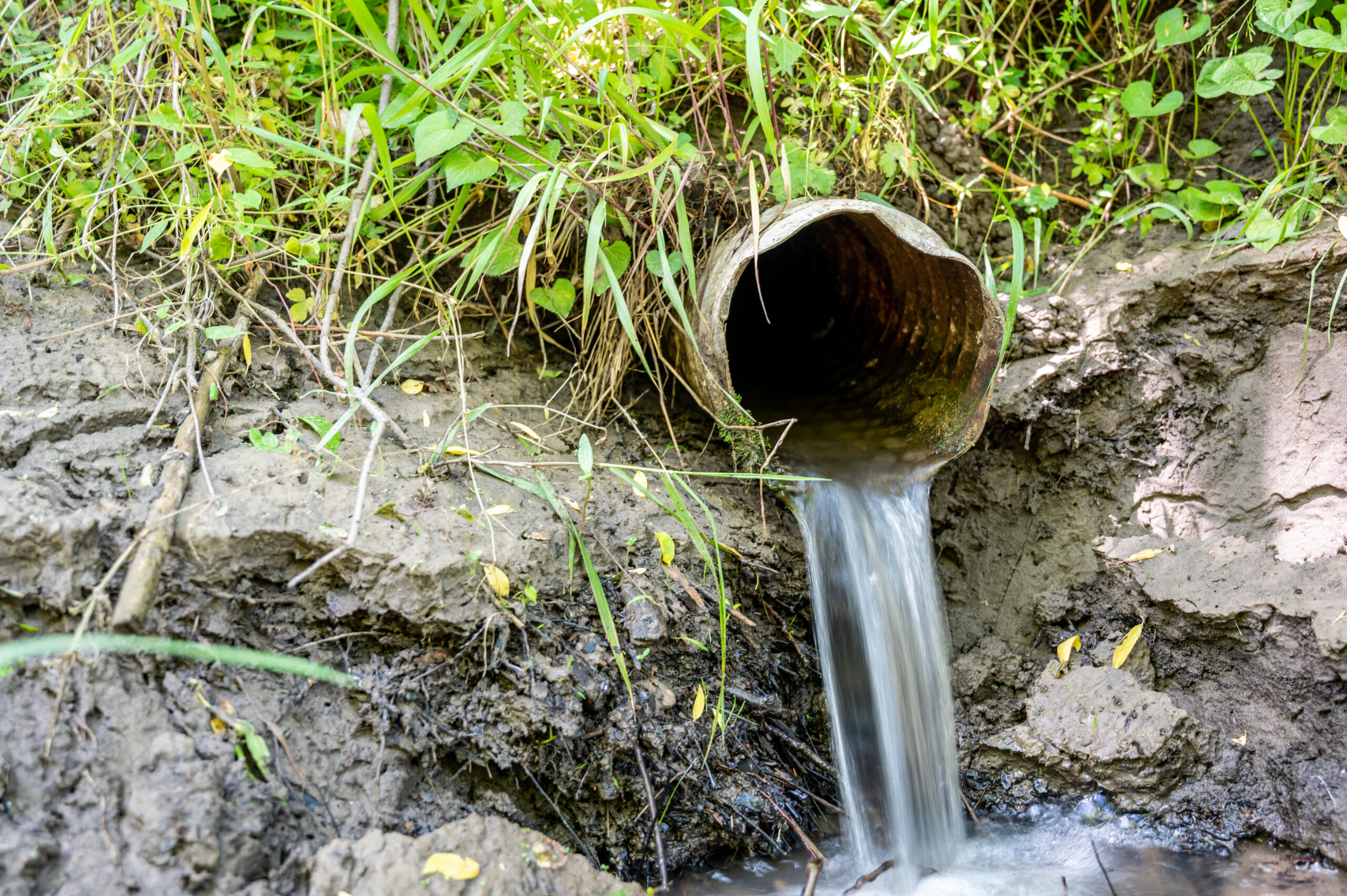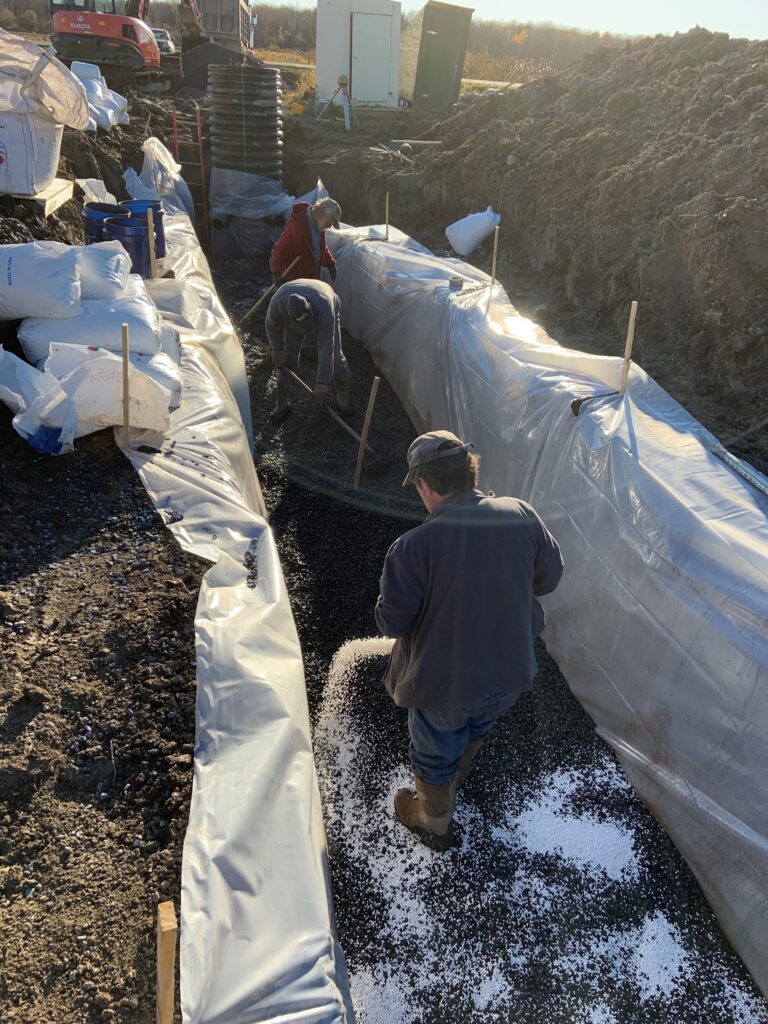
Agricultural tile drains present water quality challenges with innovative solutions.
By Matthew C. H. Vaughan
In forested watersheds, we are accustomed to seeing tranquil headwater streams and cascading rivers flow through the trees. In cities, gutters and storm drains replace these natural features to move water through the urban environment. For agricultural landscape, however, hidden “tile drains” make up water conveyance systems that are often unknown or poorly understood.
Tile drains are pipes that run under the surface of farm fields to move water away from the crop root zone and redirect it to a ditch or waterway. Where natural drainage is poor, these systems are considered critical by farmers for crop yields and management. However, their use creates challenges that demand innovative solutions to mitigate impacts on water quality.
Agricultural tile drainage is not new; the term “tile drain” comes from the early use of ceramic tiles for agricultural drainage by ancient Romans. Today, perforated plastic pipes are typically installed at 2-4 feet below the soil surface, draining excess water from large areas of land that would naturally be too wet to effectively grow crops, creating more arable land. Tile drainage is widely used in the Northeast United States and around the country. By about 1970, these systems drained roughly half of the wetlands in the U.S. In the Lake Champlain Basin, there are some agricultural subwatersheds that are estimated to be 70% tile-drained.
For a farmer, tile drains have several benefits, including increased crop yields and improved access to fields during wet conditions. Because tile drains reduce surface water runoff and erosion and can reduce phosphorus loss in some cases, their use was once considered to be a best management practice to benefit water quality. More recently, studies have shown that in some cases tile drains can increase the total amount of water and nutrient runoff from a field, especially when cracks in dry soils create pathways for water, sediment, and nutrients to travel through the field to tile drains.
Recent water quality challenges in Lake Erie became a warning sign for the potential impacts of tile drains and how they can combine with other watershed pressures. Actions spurred by the Clean Water Act since the 1960s had successfully lowered total phosphorus inputs to Lake Erie by about 20,000 metric tons annually by the 1990s. Although total phosphorus inputs have remained relatively stable since then, dissolved phosphorus inputs have increased, in a change that has been called the “re-eutrophication” of Lake Erie. In 2014, cyanobacteria blooms driven by these changing phosphorus inputs caused water service interruption for 400,000 Ohio residents. Along with several factors such as climate change, farm management changes, and invasive species, tile drains have been identified as a potential major contributor to increased dissolved phosphorus in western Lake Erie.

The Lake Champlain Basin Program (LCBP) and local partners began to focus on tile drains in 2015, when the Vermont state legislature passed a law to require agricultural regulations to be updated and include requirements to reduce nutrient loss from tile-drained fields. The law also formed the Tile Drain Advisory Group, which includes farmers, tile drain installers, extension workers, agronomists, state agencies, LCBP, and other water quality experts to tackle this issue in the Lake Champlain Basin. The LCBP worked with these partners to better understand this issue and develop management strategies.
We began our work by collecting existing knowledge about tile drains and their influence on hydrology and nutrient transport. LCBP supported a comprehensive literature review that compiled relevant tile drainage research from other parts of the country. This science had a direct impact: after submission to the Vermont state legislature, the legislature rapidly adopted Required Agricultural Practices that all farms must follow when installing or maintaining tile drainage.
In addition to collecting knowledge from other regions, we knew that collecting local data on tile drain discharge would be critical to understand their impact in the Lake Champlain Basin. Since 2017, LCBP has supported water quality monitoring at 17 tile drain sites in regions with varying agricultural practices and soil types. Among several important findings, this work has shown us that tile drain discharge contributes about a quarter of the phosphorus load to Jewett Brook, the tributary to Lake Champlain with the highest phosphorus concentrations. Following the conclusion of these monitoring studies, LCBP now funds two separate research farms (one in New York and one in Vermont) that will use paired watershed experimental designs to better understand the impacts of tile drains and solutions for minimizing their contributions to nutrient pollution.

Although on-the-ground research is critical, the Tile Drain Advisory Group also knew that computational modeling would be a powerful tool to cost-effectively answer questions about which practices would best limit phosphorus loss on tiledrained fields. LCBP supported a study to compare surface and tile drain runoff and phosphorus loading under multiple management scenarios. From this research, we gained evidence for the benefit of stacked conservation practices in tile-drained fields. For example, although no till or cover cropping practices alone have benefits to reducing phosphorus loss, we found that combining these practices has a greater effect on reducing phosphorus loss than either practice in isolation.
Finally, LCBP supports work to design and test tile drain filters that chemically capture phosphorus at the end of a pipe network before it enters a waterway. The science for this type of phosphorus removal is well understood; the remaining challenge is to develop systems that will be effective in the field, low-maintenance and low-cost. LCBP has funded two pilot studies which achieved promising results, with an 80% reduction of dissolved phosphorus concentrations and loads from tile-drained fields. These successes have fueled increased interest and investment; LCBP continues to support tile drain filter applications in critical nutrient source areas and extended our testing of this technology to include a stormwater pond outflow.
Because of their importance for farm viability, tile drains are here to stay. As with other watershed changes and pressures, we need to understand their watershed-scale impacts, design solutions to reduce these impacts, and share our findings with watershed managers and policymakers. Getting the word out about this work was a motivating factor to launch the LCBP Science Blog, which provides easy-to-read summaries of our research findings to partners who can use the knowledge to improve water quality. Shared knowledge, new tools, and science-driven management together create the opportunity to make progress toward our water quality goals.
This article was originally published in the Fall 2023 edition of Interstate Waters magazine. Matthew C. H. Vaughan, Ph.D., is a NEIWPCC environmental analyst, and chief scientist at the Lake Champlain Basin Program.
References
Klaiber, L.B.; Kramer, S.R.; Young, E.O. Impacts of Tile Drainage on Phosphorus Losses from Edge-of-Field Plots in the Lake Champlain Basin of New York. Water 2020, 12, 328. https://doi.org/10.3390/w12020328
Moore, J. (2016). Literature Review: Tile Drainage and Phosphorus Losses from Agricultural Land (Technical Report No. 83). Grand Isle, VT: Lake Champlain Basin Program. https://www.lcbp.org/wpcontent/uploads/2017/01/83_TileDrainage_LitReview.pdf
Smith, D.R., K.W. King, and M.R. Williams. 2015b. What is causing the harmful algal blooms in Lake Erie? J. Soil Water Cons. 70(2):27A-29A. https://doi.org/10.2489/jswc.70.2.27A
Smith, D.T., K.W. King, L. Johnson, W. Francesconi, P. Richards, D. Baker and A.N. Sharpley. 2015b. Surface runoff and tile drainage transport of phosphorus in the Midwestern United States. Journal of Environmental Quality. In Press, doi: 10.2134/jeq2014.04.0176. https://pubmed.ncbi.nlm.nih.gov/26023968/
King, K.W., M.R. Williams, and N.R. Fausey. 2015. Contributions of systematic tile drainage to watershed phosphorus transport. Journal of Environmental Quality. In Press, doi: 10.2134.jeq2014.04.0149. https://pubmed.ncbi.nlm.nih.gov/26023967/
Watson, Susan B., et al. “The re-eutrophication of Lake Erie: Harmful algal blooms and hypoxia.” Harmful algae 56 (2016): 44-66. https://www.sciencedirect.com/science/article/abs/pii/S1568988315301141
Braun, D., Stone Environmental Inc. (2023). Assessment of Tile Drainage Systems in Addison County and the Jewett Brook Watershed (Technical Report # 104). Grand Isle, VT. Lake Champlain Basin Program. https://www.lcbp.org/wp-content/uploads/2016/03/104_Assessment-of-Tile-Drainage-Systems-in-Addison-County-and-the-Jewett-Brook-Watershed.pdf
Winchell, M. Stone Environmental. (2020). Refinement of Critically Needed Assessment Tools for Tile Drainage Phosphorus Loading in the Lake Champlain Basin (Technical Report No. 96). Grand Isle, VT: Lake Champlain Basin Program.
Stone Environmental, Inc. (2019). Assessment of Phosphorus Loads in Tile Drainage in the Jewett Brook Watershed of St. Albans Bay, Lake Champlain (Technical Report No. 92). Grand Isle, VT: Lake Champlain Basin Program. https://lcbp-089519.s3.us-east-2.amazonaws.com/techreportPDF/92_20190830-Jewett-Brook-Tile-Drain-Assessment-Final-Report-Approved_web.pdf
Moore, J. (2016). Literature Review: Tile Drainage and Phosphorus Losses from Agricultural Land (Technical Report No. 83). Grand Isle, VT: Lake Champlain Basin Program. https://www.lcbp.org/wpcontent/uploads/2017/01/83_TileDrainage_LitReview.pdf